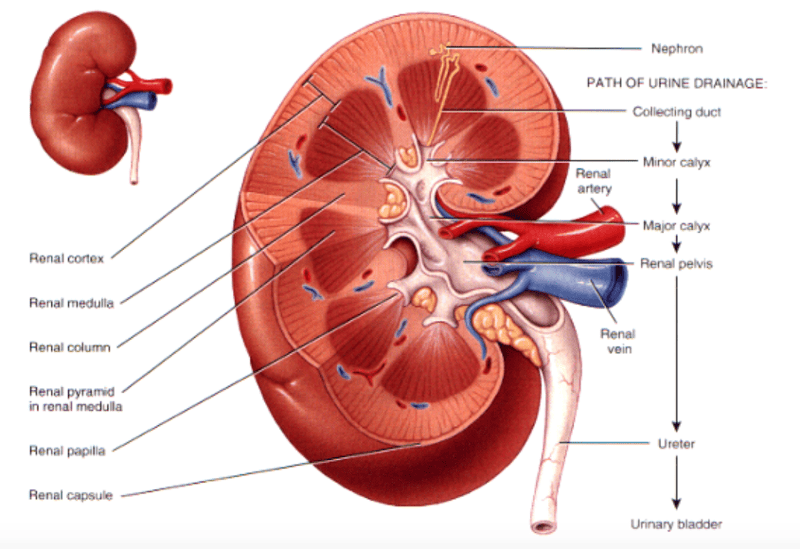
Labeling the kidney
...
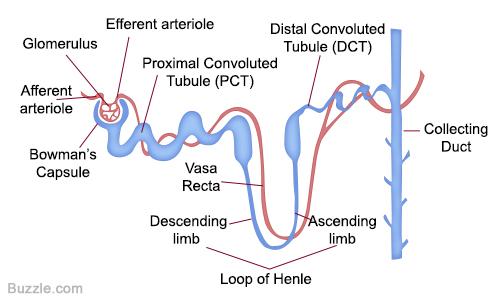
Labeling the nephron
...
Function and tissue type of the Afferent arteriole
Function: Carry blood from renal artery into glomerulus
Tissue: Smooth muscle
Function and tissue type of Glomerulus
Function: Components that carry out the primary filtering action of the kidney connect blood vessels of the kidney to other structure called tubules
Tissue: Simple squamous endothelium
Function and tissue type of Bowman's capsule
Function: Performs first step of filtration of blood
Tissue: Simple squamous epithelium
Function and tissue type of efferent arteriole
Function Delivers blood away from the capillaries of the kidney
Tissue: Smooth muscle
Function and tissue type of proximal convoluted tubules
Function: Active and passive reabsorption
Tissue: Simple Squamous
Function and tissue type of descending limb
Function: Water reabsorption
Tissue: Simple cuboidal epithelium
Function and tissue of ascending limb
Function: solutes reabsorbed
Tissue: cuboidal/ columnar cells
Function and tissue of convoluted tubule
Function: Active secretion of solutes back into filtrate some reabsorption (sodium/Cl)
Tissue: Simple cuboidal
Function and tissue of collecting duct
Function: Transports materials across membrane; reabsorbs water
Tissue: Squamous epithelium
What causes high pressure and controls filtration rate in the glomerulus?
Efferent arteriole diameter decreased; By adding resistance to the efferent arteriole it causes high pressure
What is the glomerular filtration rate(GFR)?
Volume per minute; determines how well the blood is filtered by the kidneys, way to measure kidney function
How is water transported out of the tubule?
Osmosis? Passive?
Name one consequence of having a very short loop of Henle in the nephron
...
Collecting ducts
Region of the Nephron that regulatory hormones target
Aldosterone
Causes conservation of sodium and water, and secretion of potassium, increasing blood volume and therefore blood pressure
Anti- Diuretic Hormone
Increases water permeability by translocating aquaporin water channels in the plasma membrane
Active transport
Where reabsorption of sodium and chloride in the ascending limb of the loop of Henle occurs
Countercurrent multiplication
Movement of solutes changes interstitial osmolarity and allows the reabsorption of water from tubular fluid to produce more concentrate urine
Loop of Henle
Site of countercurrent multiplication in the nephron
Location and function of the adrenal gland
Location: At the top of each kidney
Function: To produce hormones that help the body control blood sugar, burn proteins and fat, and regulate blood pressure
Describe the effect of alcohol on ADH and the physiological effects of excess alcohol consumption
ADH stops you from urinating, it makes your body hold on to water when your dehydrated. Alcohol reduces how much ADH you produce, therefore increasing urine production. By drinking alcohol you will still be dehydrated or become and it causes electrolyte imbalances.
Urine leaves kidneys by ________ and collects in the __________.
Ureters, bladder
_________ expands to store urine that eventually leaves through the _________.
Bladder; urethra
Micturition
Urination occurs through the urethra
Urine pathway
Kidneys, ureters, bladder, urethra, outside
Pigment responsible for the urines yellow color
Urochrome
Average pH of urine
6
Inorganic constituents of urine
sulfates and phosphates
Organic constituents of urine
Glucose and blood
Human kidney composed of __ layers
3
Layers of kidney
Renal cortex, renal medulla, and renal Pelvis
Renal cortex
Outermost layer; contains about 1 million nephrons, the filtering units that form urine
Renal medulla
Middle layer; segregated into renal pyramids
Renal pelvis
Funnel- shaped; extending inward from the hilum; collects urine from the pyramids and conveys it into the ureter for passage to the urinary bladder
Major calcyes
larger, primary fingerlike extensions of renal pelvis
Minor calcyes
subdivisions of major calcyes
How many deciduous and permanent teeth do humans have?
Deciduous: 20
permanent: 32
How many deciduous and permanent teeth do cats have?
Deciduous: 15
Permanent: 30
Tooth labeling
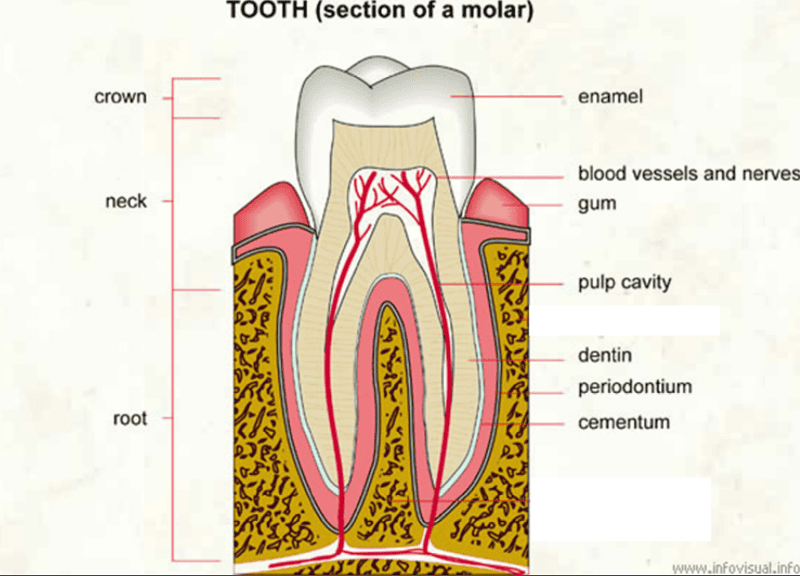
Name two mechanisms acting from outside the kidney (extrinsic) that contributes to kidney function
bp and adh
Which substance is actively reabsorbed across the membranes of the proximal convoluted tubule using a carrier method?
glucose
In a diabetic person, what substances remains in the urine
glucose
A high pressure environment inside the __________ causes a plasma- like substance to squeeze out into the Bowman’s capsule.
glomerulus
This process in urine formation is called
filtration
Reabsorption of useful substances from the filtrate primarily occurs in the
pct
_____________ changes the composition of urine and is the opposite of reabsorption
Secretion
Which structure collects urine from several nephrons distal tubules and carries it through the medulla pyramids to the minor calyces?
Collecting duct
Blood composition depends on 3 major factors
diet, urinary output, cellular metabolism
An increase in ____results in corresponding increase in filtration rate and urine output.
bp
Filtrate has been reduced by what percentage once it leaves the proximal convoluted tubule
65%
The descending limb of the loop of Henle is thinner and is made of what type of epithelium?
simple squamous
Both male and female reproductive systems include:
Reproductive organs or gonads that produce gametes(reproductive cells) and hormones
Ducts that transport and receive gametes
Accessory glands or organs that secrete fluids
Perineal structures associated with the reproductive system known as external genitalia
What are perineal structures also known as
External genitalia
Essential primary organs in both men and women are called
gonads
Gonads are
gamete producing organs
Gonads in men what do they excrete
Testes; sperm
Gonads in women and what do they excrete
Ovaries; eggs and ova
Testes exocrine and endocrine function
Sperm; testosterone
The endocrine products of the female reproductive system are estrogen and
progesterone
Cremaster muscles
Raise and lower testes in response to changes in body temp
Dense connective tissue capsule called the __________________ cover each testis
Tunica albuginea
These sheaths(tunica albuginea) house highly coiled seminiferous tubules (sperm forming factories)
Tubules empty into rete testis then the epididymis
Interstitial cells are located in between seminiferous tubules
Produce testosterone
Epididymis
Structure and function
Structure: Elongated that surrounds the testes superior aspect
Function: Site of maturation of sperm
Ductus deferens/ vans deferns(sperm duct)
Structure and function
Structure: Enclosed along blood vessels/ nerves in a connective sheath (Spermatic cord)
Function: Conveys sperm from epididymis to ejaculatory duct
Ejaculatory duct
Contraction of this duct during ejaculation propels sperm through the prostate
Urethra
Sperm travels through/ out of body
Estrogen increases the size of __________ during puberty
mammary glands
If fertilization and subsequent implantation does not occur, the corpus luteum undergoes apoptosis and after several months becomes the ______________
corpus albicans
Which hormone stimulates the growth of ovarian follicles and stimulates sperm production?________
FSH
Falling estrogen levels causes what hormone do decline?
LH
What structure of the sperm contains enzymes to help the sperm penetrate the egg?
Acrosome
Which stage of the menstrual cycle begins after ovulation?
secretory
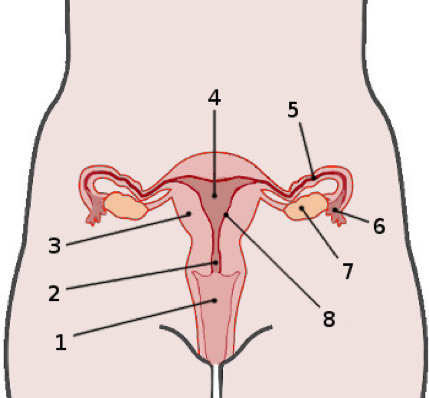
Label this
...
Endocrine glands are ________
ductless = they do not have ducts to take their secretions to specific sites
Instead, hormones are secreted directly into capillaries and circulate in the blood throughout the body
Hyposecretion
a deficiency of a hormone
Hypersecretion
excess secretion of a hormone
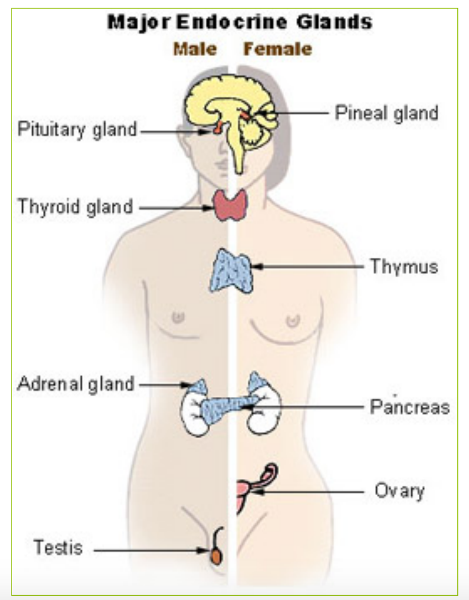
...
Two major portions of pituitary gland
Posterior pituitary gland
Anterior pituitary gland
Pituitary connected to the hypothalamus of the brain by a slender stalk called the
infundibulum
Gonadotropins—follicle-stimulating hormone (FSH) & luteinizing hormone (LH)
Regulate gamete production, hormonal activity of gonads
Adrenocorticotropic hormone (ACTH)
Regulates endocrine activity of cortex portion of the adrenal gland
Thyroid-stmulating hormone (TSH)/thyrotropin
Influences growth and activity of thyroid gland
2 hormones of the Thyroid gland
Function and target organ
Hormones: Thyroxine(T4) and Triiodothyronine (T3)
Function: Control the rate of metabolism
Target organ: everywhere in the body
Another hormone of the thyroid gland
Function and target organ
Calcitonin
Function: Controls calcium concentration in the body by stimulating bone deposition
Target: Bone, kidneys, and blood
Parathyroid glands
Function and target
Parathormone(PTH)
Function: Regulates calcium and phosphate metabolism. Antagonist to calcitonin
Target: Bone, Kidneys, and blood
Adrenal cortex hormones
Aldosterone, Cortisol, Androgens and estrogens
Aldosterone function and target
Function: Decrease the rate of sodium-ion excretion and to increase the rate of potassium- ion excretion
Target: Kidneys
Cortisol function and target
Function: stimulates glycogen formation white it decreases the rate of glucose utilization in body cells
Target: liver
Androgens and estrogens function and target
Function: Involved in outset of puberty and development of secondary sexual characteristics
Target: reproductive system
Adrenal medulla hormones
Epinephrine and norepinephrine
Epinephrine and norepinephrine function and target
Function: Promotes the flight- or- flight response
Target: Everywhere in the body
Pancreas hormones
Insulin and glucagon
Insulin function and target
Function: lowers the blood glucose level
Target: body cells
Glucagon function and target
Function: Stimulates an increase in blood sugar levels. Antagonist to insulin
Target: liver
Ovary hormones
Estrogen and progesterone
Estrogen function and target
Function: Promotes development of secondary sexual characteristics, development and maintenance of female secondary sex characteristics and promotes development of the mammary glands.
Target: The whole body, uterus and breasts
Progesterone function and target
Function: Prepares uterus for implantation of the fertilized ovum and maintains pregnancy, and promotes development of the mammary glands.
Target: Uterus and breasts
Testis hormone
Function and target
Testosterone
Function: Responsible for the development of the male reproductive system and secondary male sexual characteristics
Target: Gonads, ducts, and glands
Thymus hormone
Function and target
Thymosin
Function: Promotes maturation and specialization of T cells
Target: Lymphocytes